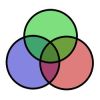Some, All, None and Logic
Lesson Plans > Mathematics > Geometry > LogicSome, All, None and Logic

Every year, as part of the geometry curriculum, my students do a unit on logic, and one of the first things they learn about is statements and their negations. I ask my students, one at a time, to give me a statement, and then identify whether it is true or not.
Before they begin, however, I highlight a few things I encourage them to look for when crafting a statement:
- Avoid subjective qualifiers. For example, "Candy corn is delicious" is not a good statement, since "delicious" is a subjective qualifier, and therefore the truth value of the sentence depends on who is speaking.
- Avoid self-referencing sentences. For example, "This sentence is false" has no truth value, since assuming either truth value results in a contradition.
- Be precise in defining the subject of your sentence. "Trees lose their leaves." should be made more precise by specifying which trees. In this case, students might choose "Some trees...", "All trees..." or "No trees...". The sentence, as stated in another of those ways, is a statement with a clear truth value.
After we've done some practice creating statements, I explain about negations. A negation is a statement that means exactly the opposite of the original statement. In many cases, creating a negation is obvious and easy. The negation of "John is five years old." is "John is NOT five years old."
Occasionally I'll have a student who tries to tell me that the negation of that statement is "John is six years old." I point out that this can't be the case, because if John was actually FOUR years old, both of those statements would have a truth value of FALSE, so they can't be opposites.
Furthermore, a statement and its negation must cover all possibilities. If all possibilities are not covered, you don't have the negation correct.
The big problem comes when a student has given me a statement involving the word SOME.
Yesterday a student gave me the following: "Trees are turning colorful." We identified a few issues (subjective modifier, ambiguous subject). Eventually, the student rewrote the statement as "Some trees in Maine are changing color."
This is where the fun begins, because students have to identify how to write the negation of this statement, and we come up with a variety of possibilities:
Some trees in Maine are NOT changing color.
Many trees in Maine are changing color.
Some trees NOT in Maine are changing color.
All trees in Maine are changing color.
It's easy to see that the first three don't work; they all have the same truth value as the original statement, so they can't be the negation. However, the last statement is false, so it's hard for students to understand why it isn't the opposite.
I give them the following example to show why "some" and "all" are not opposites:
- Some of my geometry students are teenagers. (TRUE)
- All of my geometry students are teenagers. (also TRUE)
This helps my students understand that "some" and "all" are not opposites. But what is the opposite of some?
To understand this I ask my students, "How many teenaged geometry students would I have to have in order to be able to say, Some of my geometry students are teenagers?" The answer is, I have to have at least one.
So what is the opposite of "at least one"?
"NONE!"
So the negation of "Some trees in Maine are changing color" is "No trees in Maine are changing color."
As a follow-up to this, we take my statement "All of my geometry students are teenagers" and ask, "What is the negation of this statement?"
The most common response to this is, "None of my geometry students are teenagers."
This also can mystify the students, so after a few attempts, I'll say, "What has to happen in order for this statement to be false?"
The answer will come back, "At least one of your students needs to be not a teenager."
"And what is the word that means at least one?"
"SOME!"
So the opposite of "All of my geometry students are teenagers" is "Some of my geometry students are NOT teenagers."
So "some" is the opposite of "none" and "some are not" is the opposite of "all". These examples help students wrap their brains around how to find the negation of statements using some of these words.

